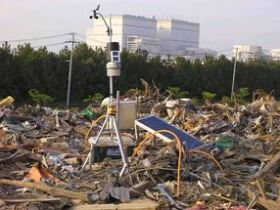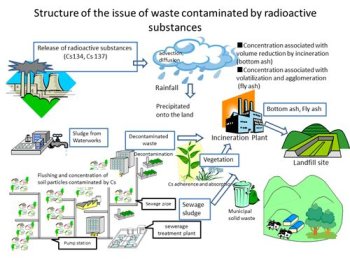Ⅰ-1.Appropriate treatment and disposal of disaster waste and waste contaminated by radioactive substance
1. Countermeasures for disaster waste
In order to deal with the issues associated with the large volumes of disaster waste generated in the earthquake and Tsunami of March 11, 2011, the “Disaster Response Network”, comprising specialists in relevant fields, was created immediately following the disaster. This network collects and manages information and know-how in response to the various technical issues arising, and drafts and provides a range of technical information to support on-site response by the Ministry of the Environment and local authorities in the disaster zone. These include methodologies for the treatment of waste containing saline matter; dealing with Tsunami deposits; and prevention of fires in flammable waste at temporary disposal sites.
Technical information provided to specialists and local authorities on waste contaminated by radioactive substances (Japanese only)
- Prevention of fires from flammable waste at temporary disposal sites (supplementary to second edition)
- Prevention of fires from flammable waste at temporary disposal sites (second edition)
- The basic elements of disaster waste (first edition)
- Management of gypsum board waste
- Treatment of sludge generated from septic tanks in Tsunami disaster zone (first edition)
- Prevention of fires from flammable waste at temporary disposal sites (first edition)
- Burning of disaster waste in open dumps (first edition)
- Treatment of Tsunami deposits (second edition)
- Treatment of sewage water (the first edition)
- Weight-volume conversion of disaster waste (first edition)
- Waste containing PCBs (first edition, revised)
- Countermeasures for Tsunami sludge (first edition)
- Establishment of temporary disposal sites and related points of note (first edition)
- Treatment methods for waste containing saline matter (third edition)
- Treatment methods for fisheries waste (second edition)
In addition, NIES carried out emergency studies and research - including those on the appropriate treatment of rubble covered by seawater; Tsunami deposits; and prevention of fires in temporary disposal sites. These were subsequently reflected in directives of the Ministry of the Environment. We also dispatched researchers to the patrol teams organized by the Ministry of the Environment and implemented studies and provided technical counsel for specific topics such as the prevention of fires in temporary disposal sites, etc.


2. Countermeasures for waste contaminated by radioactive substances
We have made optimal use of our know-how, experience and networks in the field of waste management research in order to deal with the issues associated with the treatment and disposal of the large volumes and varieties of waste contaminated by radioactive substances and which are spread over large areas. We continue to implement field studies and research on the appropriate treatment and disposal of waste contaminated with radioactive Cesium, including those covering: physical characteristics and prediction of combustion dynamics; adsorption capacity assessments for soil, etc; modeling and predictions for land-fill sites and layer dynamics; assessment of treatment technologies for contaminated leachate; and standardization of measurement and analysis methods.
The know-how and outcomes resulting from these studies and activities were provided in a timely fashion to the Ministry of the Environment’s Disaster Waste Safety Evaluation Committee and are being used in technical standards and guidelines based on the Act on Special Measures Concerning the Handling of Radioactive Pollution.
In addition, the outcomes of these various initiatives have been summarized in the technical document “Proper treatment of wastes contaminated by radioactive substances”. We have made this document available on our homepage alongside an easily-understandable overview. This document is being actively applied by the central government, local authorities, and stakeholders in related enterprises.
Technical information provided to specialists and local authorities on waste contaminated by radioactive substances
- Proper treatment of wastes contaminated by radioactive substances (overview of technical document) (ENGLISH)
- Proper treatment of wastes contaminated by radioactive substances (overview of technical document) (JAPANESE)
- Proper treatment of wastes contaminated by radioactive substances (technical document, Version 4) (JAPANESE)
- Solidification test for fly ash generated from general waste contaminated by radioactive substances (JAPANESE)
- Provisional manual on survey and measurement methodologies for waste contaminated by radioactive substances (JAPANESE)
- Great East Japan Earthquake Information Page
- Ⅰ-1.Appropriate treatment and disposal of disaster waste and waste contaminated by radioactive substance
- Ⅰ-2. Clarifying behaviors for radioactive substances in multimedia (atmosphere, soil, water, plants, organisms and ecosystems, etc.)
- Ⅰ-3. Studies and projections on environmental change originating from the disaster and associated effects
- Ⅰ-4. Details of research outcomes presented at the NIES Public Symposium
- Ⅰ-5. An Overview of Research on Disaster Environment
- Ⅰ-6. (1) Tsukuba City radioactive substances and radiation measurements
- Ⅰ-6. (2) Research outcomes etc., from NIES researchers (Presented prior to the occurrence of the Great East Japan Earthquake)
- Ⅰ-6. (3) Kankyo Tenbodai (Environmental Observatory), search service for disaster information relating to environment in environmental information media
- Ⅱ. Information Sources Related to the Disaster
- An Overview of Research on Disaster Environment
